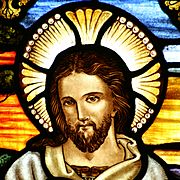East–West Schism facts for kids
The East-West Schism was a big event in Christianity's history. It describes how the Christian Church split into two main parts during the Middle Ages. The Western part later became the Roman Catholic Church. The Eastern part is known as the Eastern Orthodox Church. Over many centuries, these two parts developed different ideas about politics and theology (religious beliefs). This split is different from an earlier one that created Oriental Orthodoxy.
During the 5th and 6th Centuries, the East and West became separated. This was partly because of invasions in the Balkan peninsula. They also spoke different languages. Latin was the main language in the West. The East mostly spoke Greek. This made it hard for them to talk to each other. The West also came under the influence of the Franks in the 700s, rather than the Byzantine rulers.
These differences were some of the problems that led to the Great Schism. Even after the official split in 1054, relations were not always completely bad. Most ordinary people probably did not feel the effects right away.
Contents
What is a Schism?
To understand the East-West Schism, it helps to know what a "schism" is. In simple words, a schism happens when a group of people or organizations has big differences. These differences cause them to divide into two or more separate groups.
The East-West Schism describes the split in the Christian Church. It divided into two major groups: Roman Catholicism and Eastern Orthodoxy. Most people agree that this official split happened in 1054. However, this separation was the result of problems that had started many years before.
Main Reasons for the Split
There were several important reasons why the Eastern and Western Churches grew apart. These included disagreements over religious beliefs and who had the most power.
The Nicene Creed and the Filioque
One big difference was about the Nicene Creed. This is a statement of Christian belief. The Roman Catholic Church changed the Nicene Creed. It added a phrase known as the Filioque.
The original Creed said:
I believe...in the Holy Spirit, the Lord, the Giver of Life,who proceeds (comes) from the Father,
who with the Father and the Son together is worshipped and together glorified.
In the West, the Creed was changed to say:
I believe...in the Holy Spirit, the Lord, the Giver of Life,who proceeds from the Father and from the son...
This change meant that the Holy Spirit came from the Father and the Son. The Eastern Church believed the Holy Spirit came only from the Father. This change was made without all the Church leaders agreeing in a big meeting (an ecumenical council). This became a major point of disagreement.
Who's in Charge? The Pope's Role
Another major reason for the division was about the authority of the Pope. In the early Church, there were many important bishops. In the East, the Pope was seen as the "first among equals." This meant he was very respected, but not necessarily in charge of everyone.
However, Rome claimed that the Pope had special authority because he was the successor of Saint Peter. At first, the Eastern Orthodox Church did not mind the Pope's power over the Western Christians. But then, the Pope decided he also had power over the Eastern Church. He tried to make his power known to the Eastern leaders (Patriarchs).
For example, in 865, Pope Nicholas wrote a letter claiming the Pope's power stretched "over all the earth, that is, over every church." He also tried to overturn a decision about two Patriarchs of Constantinople, Photius and St. Ignatius. This was seen as going beyond his authority by the Eastern Church.
Not all Popes after Nicholas were as extreme. However, Pope Leo IX was. In 1053, Michael Cerularius, the Patriarch of Constantinople, tried to have friendly talks with Pope Leo IX. But a group sent by Pope Leo IX, led by Cardinal Humbert, accused Constantinople of changing the Nicene Creed. The Eastern Church accused the West of changing it. This led to Cardinal Humbert placing a document of Excommunication (expulsion from the Church) against Michael Cerularius on the altar of the Hagia Sophia. This act made the Great Schism official, as each Church then excommunicated the other.
Images for kids
-
Hagia Sophia, the main church of Constantinople when the split happened.
-
An icon showing Emperor Constantine (center) and the bishops at the First Council of Nicaea (325). They are holding the Niceno–Constantinopolitan Creed of 381.
See also
 In Spanish: Cisma de Oriente para niños
In Spanish: Cisma de Oriente para niños




